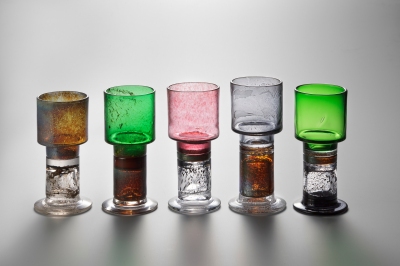 Kaj Franck, Goblets, 1969. Blown glass. photo: rauno träskelin / designmuseo
Kaj Franck, Goblets, 1969. Blown glass. photo: rauno träskelin / designmuseo
“Franck was a protagonist of anonymity in design,” writes Auli Suortti-Vuorio of the Finnish designer Kaj Franck (1911-1989), who felt a designer’s name should be reserved only for unique, non-functional pieces. The legacy of his designs, including the utilitarian cups, bowls, and goblets that appear in “Kaj Franck – Universal Forms” at Designmuseo in Helsinki, demonstrates that Franck’s prowess as a designer and his ability to create powerfully statuesque design forms denied him the very anonymity he aspired to with his work.
 A brown pitcher from the Kartio series Franck designed for Iitala. courtesy: iitala
A brown pitcher from the Kartio series Franck designed for Iitala. courtesy: iitala
“Kaj Franck – Universal Forms” is one of three summer exhibitions celebrating the 100th anniversary of Franck’s birth. An artist, designer, and teacher, Franck worked prolifically across many media, using glass, ceramics, plastic, metal, and fabrics, all of which are represented in the exhibition. He created everyday objects like dishes and furniture that he once told his employers he wanted to be “so obvious you won’t even notice them.” The exhibition showcases work from every stage of Franck’s career, including unique glass pieces. It starts in the 1940s when Franck began his sixteen-year tenure at Arabia and includes pieces he designed for the Nuutajärvi Glass Factory, where he worked for almost thirty years. He designed some of his most famous pieces for Iitala, including the Teema line of porcelain tableware and the Kartio series of glass cups and pitchers from 1958 that are still available in a range of clear glass colors.
 Kaj Franck, Bowl, 1960s. Multi-colored glass pieces. photo: rauno träskelin / designmuseo
Kaj Franck, Bowl, 1960s. Multi-colored glass pieces. photo: rauno träskelin / designmuseo
The retrospective coincides with two other exhibitions about Franck. Arabia will display some of his designs at their Museum Gallery until August 26, while the Designmuseo will complement “Kaj Franck – Universal Forms” with a special show of work from 26 of Franck’s students. Franck was the artistic director of the Institute of Industrial Art in Helsinki for most of the 1960s, where he taught a course in general design in B15, the auditorium in the school’s Ateneum building. Curated by Franck’s former student Professor Simo Heikkilä and art historian Teija Isohauta, “B15 – Kaj Franck’s Students” uses design, art, and film created by Franck’s students, including glass art from Perrti Metsälampi, to contemplate the designer’s work and artistic legacy.
For more information on the exhibitions, visit Designmuseo’s website here. A complete list of centennial celebrations of Franck’s work is available here.
—Grace Duggan
IF YOU GO:
“Kaj Franck – Universal Forms”Through September 15, 2011 DesignmuseoKorkeavuorenkatu 23FIN-00130 HelsinkiTel: +358 (0)9.6220.5420Website: www.designmuseum.fl


